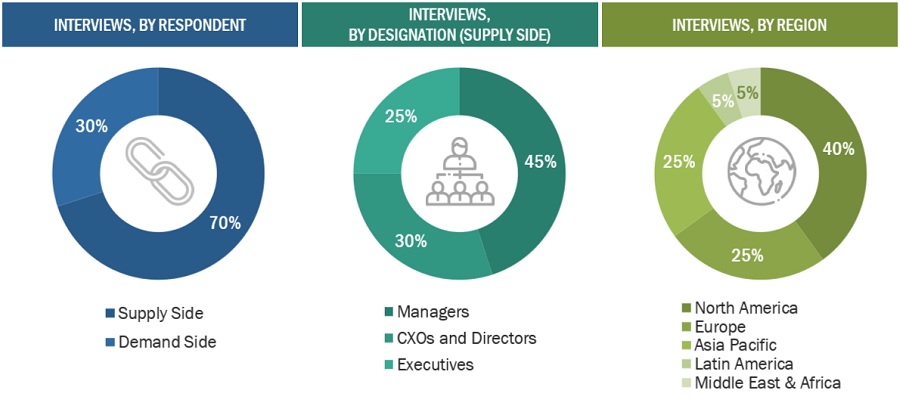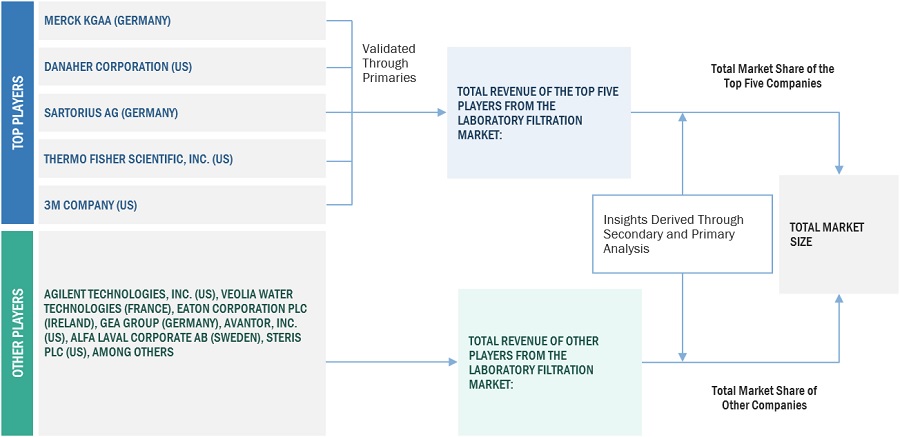This research study involved the extensive use of secondary sources, directories, and databases to identify and collect valuable information for the analysis of the global laboratory filtration market. In-depth interviews were conducted with various primary respondents, including key industry participants, subject-matter experts (SMEs), C-level executives of key market players, and industry consultants, to obtain and verify critical qualitative and quantitative information and assess the growth prospects of the market. The global market size estimated through secondary research was then triangulated with inputs from primary research to arrive at the final market size.
Secondary Research
Secondary research was used mainly to identify and collect information for the extensive, technical, market-oriented, and commercial study of the laboratory filtration market. The secondary sources used for this study include International Association of Laboratory Schools (IALS), International Federation of Pharmaceutical Manufacturers & Associations (IFPMA), National Science Foundation (NSF), American Society for Clinical Laboratory Science (ASCLS), American Filtration and Separations Society (AFS), European Federation of Clinical Chemistry and Laboratory Medicine (EFLM), Canadian Association for Laboratory Accreditation (CALA), Canadian Society for Medical Laboratory Science (CSMLS), Food and Drug Administration (FDA), European Medicines Agency (EMA), Health Canada, National Institutes of Health (NIH), and World Health Organization (WHO), research journals; corporate filings such as annual reports, SEC filings, investor presentations, and financial statements; press releases; trade, business, professional associations and among others. These sources were also used to obtain key information about major players, market classification, and segmentation according to industry trends, regional/country-level markets, market developments, and technology perspectives.
Primary Research
Extensive primary research was conducted after acquiring basic knowledge about the global laboratory filtration market scenario through secondary research. Several primary interviews were conducted with market experts from the demand side, such as pharmaceutical and biotechnology companies, CROs, CMOs, hospitals & clinical laboratories, and academic & research institutes, and experts from the supply side, such as C-level and D-level executives, product managers, marketing & sales managers of key manufacturers, distributors, and channel partners. These interviews were conducted across six major regions, including the Asia Pacific, North America, Europe, Latin America, Middle East and Africa. Approximately 70% and 30% of the primary interviews were conducted with supply-side and demand-side participants, respectively. This primary data was collected through questionnaires, e-mails, online surveys, personal interviews, and telephonic interviews.
The following is a breakdown of the primary respondents:

To know about the assumptions considered for the study, download the pdf brochure
Market Size Estimation
Both top-down and bottom-up approaches were used to estimate and validate the total size of the laboratory filtration market. These methods were also used extensively to estimate the size of various subsegments in the market. The research methodology used to estimate the market size includes the following:
Bottom-up Approach
-
The key players in the industry and market have been identified through extensive secondary research
-
The revenues generated from the laboratory filtration business of leading players have been determined through primary and secondary research
-
All percentage shares, splits, and breakdowns have been determined using secondary sources and verified through primary sources

To know about the assumptions considered for the study, Request for Free Sample Report
Top-down Approach
After arriving at the overall market size from the market size estimation process, the total market was split into several segments and subsegments.

Data Triangulation
After arriving at the market size from the market size estimation process explained above, the total market was divided into several segments and subsegments. To complete the overall market engineering process and arrive at the exact statistics for all segments and subsegments, data triangulation and market breakdown procedures were employed, wherever applicable. The data was triangulated by studying various factors and trends from both the demand and supply sides.
Market Definition
Laboratory filtration refers to the separation of solid particles from liquids or gases using a filter medium in a controlled laboratory setting. Laboratory filtration products include filters & filter media, filtration assemblies, and filtration accessories used for laboratory-scale physical and chemical processes. This market includes laboratory filtration products that are utilized by pharmaceutical & biotechnology companies, academic & research institutes, and hospitals & clinical laboratories.
Stakeholders
-
Laboratory filtration equipment and accessory manufacturing companies
-
Laboratory filtration equipment and accessory distributors
-
Pharmaceutical and biotechnology companies
-
Hospitals and clinical laboratories
-
Academic and research institutes
-
Life science companies
-
Market research and consulting firms
-
Venture capitalists and investors
-
Contract research organizations (CROs)
-
Government organizations
-
Private research firms
Report Objectives
-
To define, describe, and forecast the laboratory filtration market based on product, material, technique, type, end user, and region
-
To provide detailed information regarding the major factors influencing market growth (such as drivers, restraints, opportunities, and challenges)
-
To strategically analyze micromarkets1 with respect to individual growth trends, prospects, and contributions to the overall laboratory filtration market
-
To analyze opportunities in the market for stakeholders and provide details of the competitive landscape for market leaders
-
To forecast the size of the market segments with respect to six main regions: North America, Europe, the Asia Pacific, Latin America, the Middle East, and Africa
-
To profile the key players in the laboratory filtration market and comprehensively analyze their product portfolios, market positions, and core competencies
-
To track and analyze competitive developments in the laboratory filtration market, such as acquisitions, product launches, expansions, agreements, partnerships, and collaborations
-
To benchmark players within the laboratory filtration market using the ‘Company Evaluation Matrix' framework, which analyzes market players based on various parameters within the broad categories of business strategy and product strategy
1 Micro markets are the further segments and subsegments of the laboratory filtration market included in the report
Available Customizations
With the given market data, MarketsandMarkets offers customizations as per the company’s specific needs. The following customization options are available for this report:
Portfolio Assessment
-
Product Matrix, which gives a detailed comparison of the product portfolios of the top three companies.
Company Information
-
Detailed analysis and profiling of additional market players (up to three).
Geographical Analysis
-
A further breakdown of the Rest of Asia Pacific laboratory filtration market into countries
-
A further breakdown of the Rest of European laboratory filtration market into countries
-
A further breakdown of the Rest of Latin American laboratory filtration market into countries
-
A further breakdown of the Rest of Middle East laboratory filtration market into countries



Growth opportunities and latent adjacency in Laboratory Filtration Market